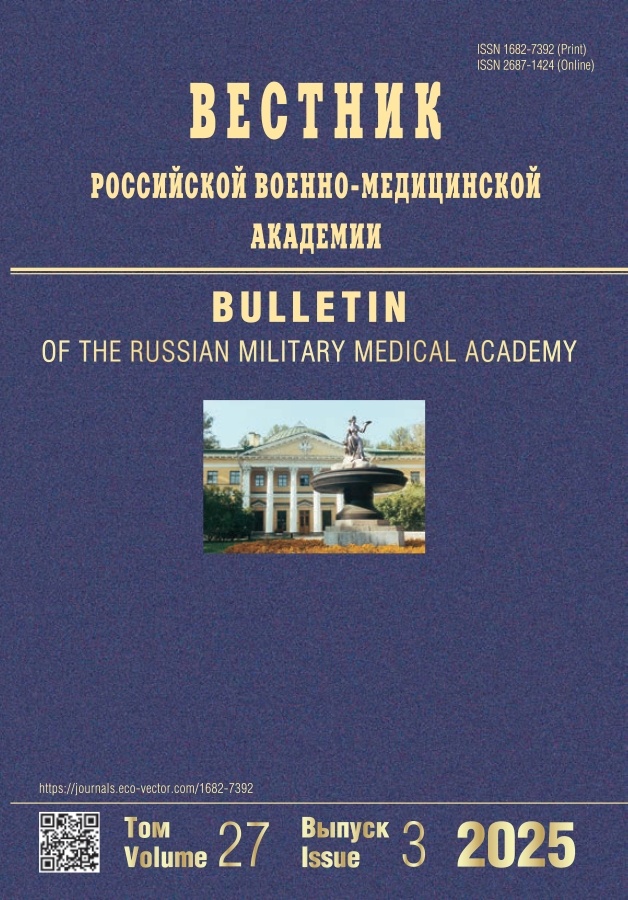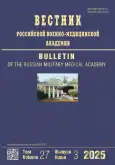Rationale for classifications of craniocerebral combat wounds inflicted by modern weapons
- 作者: Orlov V.P.1, Mirzametov S.D.1
-
隶属关系:
- Kirov Military Medical Academy
- 期: 卷 27, 编号 3 (2025)
- 页面: 321-330
- 栏目: Original Study Article
- URL: https://bakhtiniada.ru/1682-7392/article/view/319563
- DOI: https://doi.org/10.17816/brmma678185
- EDN: https://elibrary.ru/KLLBGI
- ID: 319563
如何引用文章
详细
BACKGROUND: During the Great Patriotic War, craniocerebral combat wounds were classified. Currently, gunshot wounds demonstrate a greater variety, severity, and extent of tissue injury in craniocerebral regions on the periphery of the wound canal compared to wounds from past wars. Furthermore, advanced diagnostic techniques that can identify previously undescribed cerebral wound canals, which were generally considered fatal, are now available. Thus, new classification systems for craniocerebral gunshot wounds are required.
AIM: The work aimed to broaden the fundamental classification of craniocerebral gunshot wounds by including the current clinical and anatomical findings, facilitating a more comprehensive clinical diagnosis.
METHODS: The assessment findings and treatment outcomes of two groups of wounded patients were analyzed. Group 1 included 127 patients with craniocerebral gunshot wounds who had been treated in a military hospital during the Soviet–Afghan War. Group 2 comprised 67 wounded participants of modern armed conflicts who were treated at the Neurosurgery Clinic of the Kirov Military Medical Academy.
RESULTS: A contemporary clinical and anatomical classification of craniocerebral gunshot wounds was developed. This classification includes posterior cranial fossa (the cerebellum and brainstem) wounds. The proposed classification offers a framework for more accurate triaging based on injury severity. This facilitates decision-making for surgical prioritization, including in scenarios involving mass admissions. Primary attention should be given to patients with wound canal passing through the cortex and white matter of the brain. Generally, the more convex trajectory of the wound canal is associated with less severe brain injury. Surgical procedures are performed after stabilization of vital signs in patients with wound canals passing through the first-level (e.g., subcortical structures, ventricles, and brainstem) and second-level (e.g., cortex and cerebellar hemispheres) brain structures. The prognosis of these wounded patients largely depends on the severity and extent of damage to vital brain structures.
CONCLUSION: The developed clinical and anatomical classification is beneficial for elucidating the nature of craniocerebral gunshot wounds, facilitating a targeted triage of admitted wounded patients, ensuring surgical prioritization, and predicting the prognosis and outcome of craniocerebral wounds.
作者简介
Vladimir Orlov
Kirov Military Medical Academy
Email: vmeda-nio@mil.ru
ORCID iD: 0000-0002-5009-7117
SPIN 代码: 9790-6804
MD, Dr. Sci. (Medicine), Professor
俄罗斯联邦, 6Zh, Akademika Lebedeva st., Saint Petersburg, 194044Saidmirze Mirzametov
Kirov Military Medical Academy
编辑信件的主要联系方式.
Email: said19mirze@mail.ru
ORCID iD: 0000-0002-1890-7546
SPIN 代码: 5959-1988
MD, Cand. Sci. (Medicine)
俄罗斯联邦, St. Petersburg参考
- Zhang JK, Botterbush KS, Bagdady K, et al. Blast-related traumatic brain injuries secondary to thermobaric explosives: implications for the war in Ukraine. World Neurosurgery. 2022;167:176–183. doi: 10.1016/j.wneu.2022.08.073 EDN: TDJOTQ
- Listratenko DA, Kardash AM, Fistal EY, et al. Diagnostics and treatment of patients with gunshot injuries of the skull and brain in the conditions of war in the megapolis. Vestnik Neotlozhnoi i Vosstanovitel''noi Khirurgii. 2020;5(3):94–103. (In Russ.) EDN: KLJXLJ
- Gizatullin SK, Stanishevskiy AV, Svistov DV. Combat gunshot skull and brain injuries. Burdenko's Journal of Neurosurgery. 2021;85(5):124–131. doi: 10.17116/neiro202185051124 EDN: OHHKSH
- Samokhvalov IM, Kryukov EV, Markevich VY, et al. Ten surgical lessons from the initial stages of a military operation. Military Medical Journal. 2023;344(4):4–10. doi: 10.52424/00269050_2023_344_4_4 EDN: DSYIAP
- Baum GR, Baum JT, Hayward D, MacKay BJ. Gunshot wounds: ballistics, pathology, and treatment recommendations, with a focus on retained bullets. Orthop Res Rev. 2022;14:293–317. doi: 10.2147/ORR.S378278 EDN: ANFESY
- Kalinich JF, Emond CA, Dalton TK, et al. Embedded weapons-grade tungsten alloy shrapnel rapidly induces metastatic high-grade rhabdomyosarcomas in F344 rats. Environ Health Perspect. 2005;113(6):729–734. doi: 10.1289/ehp.7791
- Hadrup N, Sørli JB, Sharma AK. Pulmonary toxicity, genotoxicity, and carcinogenicity evaluation of molybdenum, lithium, and tungsten: a review. Toxicology. 2022;467:153098. doi: 10.1016/j.tox.2022.153098 EDN: XKBWSX
- Aaronson DM, Awad AJ, Hedayat HS. Lead toxicity due to retained intracranial bullet fragments: illustrative case. J Neurosurg Case Lessons. 2022;4(13):CASE21453. doi: 10.3171/CASE21453 EDN: OCRPZZ
- Kırık A, Yaşar S, Durmaz MO. Prognostic factors in craniocerebral gunshot wounds: analysis of 30 patients from the neurosurgical viewpoint. Ulus Travma Acil Cerrahi Derg. 2020;26(6):859–864. doi: 10.14744/tjtes.2020.89947 EDN: LMJDNY
- Roy DS, Zhang Y, Halassa MM, Feng G. Thalamic subnetworks as units of function. Nat Neurosci. 2022;25(2):140–153. doi: 10.1038/s41593-021-00996-1 EDN: XCHHLK
- Fong H, Zheng J, Kurrasch D. The structural and functional complexity of the integrative hypothalamus. Science. 2023;382(6669):388–394. doi: 10.1126/science.adh848
- Tucker DM, Luu P. Adaptive control of functional connectivity: dorsal and ventral limbic divisions regulate the dorsal and ventral neocortical networks. Cereb Cortex. 2023;33(12):7870–7895. doi: 10.1093/cercor/bhad085 EDN: EZPUZS
- Trishkin DV, Kryukov EV, Alekseev DE, et al. Military field surgery. National leadership. 2nd ed. Moscow: GEOTAR media; 2024. 1056 p. (In Russ.) doi: 10.33029/9704-8036-6-VPX-2024-1-1056 EDN: AYGYWM
补充文件















